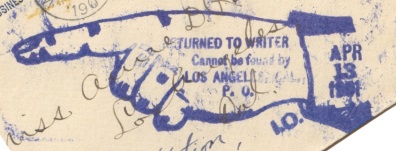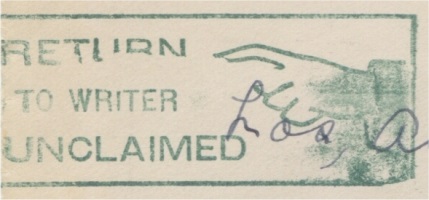
'Pointing Hand' Census Database
Contributor’s Guide
The Stamp Smarter Pointing Hands Cover Database (DB) is a Community Project to collect and document covers with the Pointing Hand (or Pointing Finger) auxiliary marking. These markings are applied to mail pieces which generally were not deliverable and were to be returned to the sender.
Any visitor to the Stamp Smarter philatelic web site can request authorization to become a Contributor, and then add new covers to this database. The following guidelines describe some of the conventions which are to be used when adding new records which describe a cover with the pointing hand type marking. Following these conventions is essential so that future Views and Users will obtain consistent results when analyzing the data from this DB.
(1) Any cover which has one or more “pointing hand” type markings is a candidate for inclusion in this DB. However, since the most significant element of the pointing hand marking is the post office where it was used, covers without readable destination addresses – such as window envelopes – are not considered to be ”good” candidates, unless the pointing hand itself includes a post office name, or there is some other postal marking that identifies the cover destination.
(2) Images of the cover should be scanned at 300 dpi when possible. It is preferred that both the front and back side of the original cover be scanned and added to the DB.
(3) The image area surrounding the pointing hand should also be cropped. It is recommended that the pointing hand be oriented so that the main portion of the text within or adjacent to the pointing hand be oriented horizontally. When there is a directive or instruction adjacent to and obviously part of the same device that imprinted the pointing hand, then that directive should be included in the crop.
When cropping machine cancel pointing hand markings, please include the CDS area with the post office name when it is present.
(4) The Contributor has the ability to enter all of the data elements associated with each cover. This entry should be as complete as possible.
(5) The Postmark information: City, State, Country, and date elements should always be entered. If one of the date elements is obscured, then that field should be left blank.
(6) The Finger Style, Return to Type, Finger Direction, should all be selected from the list of options
(7) The Other Aux Markings field should describe any other auxiliary markings found on the cover which are not directly connected to the pointing hand. If there are multiple markings, or too complex, add this information in the Comments field.
(8) The Comments field is a general field where any descriptive information is added for the benefit of a future viewer. It is generally assumed that cover data entered into the DB is the property of the Contributor. In the event that a cover is not the property of the Contributor, and the cover is taken from a public source like an auction house catalog or website, the Contributor must provide proper credit for the original source of the cover image. For example: [Source: Robert A Siegel Auctions, Sale #1234, Lot 567], or [Source: eBay seller ABCDEFG, Sept 2017].
(9) The Finger Color should be specified. The present day color may not be the original as colors can fade and there were no “standards” defined by the post office. Rather than confuse the issue with a broad range of color shades, please select the closest color from the optins offered.
(10) Color Examples

Black

Black

Black

Red

Red

Red

Magenta

Magenta

Magenta

Purple

Purple

Purple

Blue

Blue

Blue

Green
(11) There are fields for the Finger City, State, and Date. This information is critical, as it identifies the location where the pointing hand was used. A small number of these markings have the name of the post office embedded in the marking. In other cases, this information should be based on destination address information, or some form of receiving postmark. If no other information known, then duplicate the destination address here.
(12) The Finger date information should be included to the best of the Contributor’s ability. The Finger Year can usually be entered the same as the postmark year, and often the same for the month. The Finger Date can be left blank unless there is an obvious reason to include the date within the month.
(13) There is a selection group for Pointing hand Type. These are intended to be useful in selecting out different combinations of the hand, directive, and post office name. The following summarizes the options:
- (a) Pointing Hand is used for the situation where there is a pointing hand with no directive, or only a Return to Sender/Writer present.
- (b) Pointing Hand with PO is used for the above situation but with a PO name as an integral part of the marking.
- (c) Pointing Hand with Directive is used when there is an individual directive present, e.g., “Unclaimed” as part of the marking.
- (d) Pointing Hand with Directive and PO is used when there is an individual directive present, e.g., “Unclaimed” as part of the marking, along with the name of the post office.
- (e) Pointing hand with Checklist is used when there is a list of options to be checked by the postal clerk or carrier.
- (f) Pointing hand with Checklist and PO is used when there is a list of options to be checked by the postal clerk or carrier, together with the name of the post office.
- (g) Large Pointing Hand is used with the pointing hand itself is greater than 2.0” or about 50 mm in length from cuff to fingertip. This is a guideline. If it looks big relative to the usual markings, then it is Large.
- (h) Large Pointing Hand with PO is used as above, with the post office name, typically within the hand itself, or occasionally the cuff.
If there are any questions, please contact the Stamp Smarter Administrator for clarifications.





